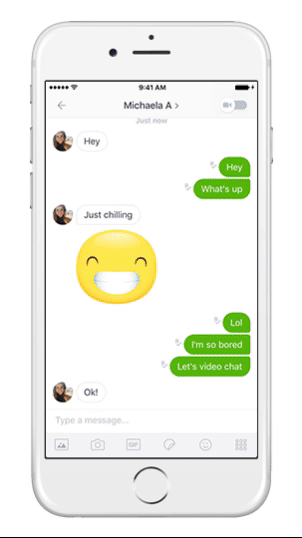Kik, the chat app that’s hugely popular among teens and young people in North America, is finally adding video chat to its service.
Rather than straight up person-to-person video calls like Apple’s FaceTime, Facebook Messenger or the recently introduced WhatsApp feature, Kik has added a less intrusive video chat option for its 300 million-plus registered users, with support for groups of up to six. While some group video calling features stuff talking heads onto a screen, essentially forcing participants to either drop what they are doing to take part or get off the line, Kik said it has carefully created an additional layer that lives above the chat conversation and is accessible to all, even when people are out and about or otherwise unable to switch their video on.
“It’s not like calling, we wanted to make it a seamless upgrade from chat,” Kik CEO and founder Ted Livingston told TechCrunch. “So the chat becomes a shared whitespace.”
In that respect, the video streams are small and float above the text chat unobtrusively. Interestingly, too, the interface deliberately puts a user’s own video feed to the side so that people can’t spend their time observing — or obsessing over — their own appearance. That way, the text conversation can continue during the video, with the option of sharing visual content like stickers, photos or videos during the video session, which is activated by flicking the video icon in the top right corner.
“We really want it to feel like a real face-to-face conversation,” Livingston explained.
Citing a Pew Internet paper which found that school children in the U.S. spent less time than ever with their friends in person, Livingston said he believes Kik video chat will provide a much-used form of communication for its young userbase.
Update: Oh hai, Facebook also launched group video calling today, too — we have more on that here.

Kik said video chat had been the number one most-requested feature from its userbase. Kik has had its head down focused on chat bots this year — it introduced its bot store in April and claims over 20,000 bots have been created — but now Livingston said the Canada-based startup will “spend a lot of time working on the core messaging experience.”
It isn’t immediately clear what that means — the Kik CEO didn’t elaborate further — but you can imagine more multimedia and the introduction of features like payments may be on the cards in 2017. You can expect that Kik will develop a more feature-rich product next year, taking plenty of cues from WeChat, the China-based app that pioneered mobile messaging as we know it today. That stands to reason in particular since Tencent, WeChat’s parent company, invested in Kik at a $1 billion valuation last year.
